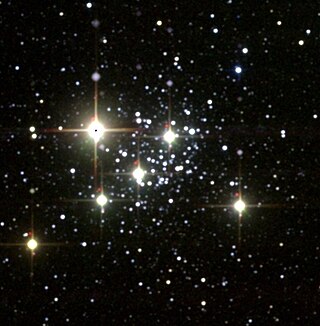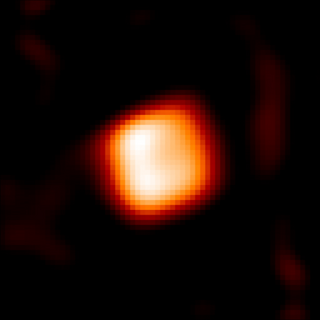
Red supergiants (RSGs) are stars with a supergiant luminosity class and a stellar classification K or M. They are the largest stars in the universe in terms of volume, although they are not the most massive or luminous. Betelgeuse and Antares A are the brightest and best known red supergiants (RSGs), indeed the only first magnitude red supergiant stars.

Mu Cephei, also known as Herschel's Garnet Star, Erakis, or HD 206936, is a red supergiant or hypergiant star in the constellation Cepheus. It appears garnet red and is located at the edge of the IC 1396 nebula. Since 1943, the spectrum of this star has served as a spectral standard by which other stars are classified.

VV Cephei, also known as HD 208816, is an eclipsing binary star system located in the constellation Cepheus, approximately 3,300 light years from Earth. It is both a B[e] star and shell star.
KW Sagittarii is a red supergiant star, located approximately 2,160 parsecs away from the Sun in the direction of the constellation Sagittarius. It is one of the largest known stars, with a diameter about 1,000 times larger than the Sun. If placed at the center of the Solar System, the star's surface would engulf Mars, coming close to Jupiter's orbit.

V354 Cephei is a red supergiant star located within the Milky Way. It is an irregular variable located over 13,000 light-years away from the Sun. It has an estimated radius of 1,139 solar radii. If it were placed in the center of the Solar System, it would extend to between the orbits of Mars and Jupiter.

MY Cephei is a red supergiant located in open cluster NGC 7419 in the constellation of Cepheus. It is a semiregular variable star with a maximum brightness of magnitude 14.4 and a minimum of magnitude 15.5.

HD 269810 is a blue giant star in the Large Magellanic Cloud. It is one of the most massive and most luminous stars known, and one of only a handful of stars with the spectral type O2.

RW Cephei is a K-type hypergiant and a semirregular variable star in the constellation Cepheus, at the edge of the Sharpless 132 H II region and close to the small open cluster Berkeley 94. It is among the largest stars known with a radius of almost 1,000 times that of the Sun (R☉), nearly as large as the orbit of Jupiter.

WOH G64 is an unusual red supergiant (RSG) star in the Large Magellanic Cloud (LMC) satellite galaxy in the southern constellation of Dorado. It is one of the largest known stars, being described as possibly being the largest star known. It is also one of the most luminous and massive red supergiants, with a radius calculated to be around 1,540 times that of the Sun (R☉) and a luminosity around 282,000 times the solar luminosity (L☉).

A hypergiant (luminosity class 0 or Ia+) is a very rare type of star that has an extremely high luminosity, mass, size and mass loss because of its extreme stellar winds. The term hypergiant is defined as luminosity class 0 (zero) in the MKK system. However, this is rarely seen in literature or in published spectral classifications, except for specific well-defined groups such as the yellow hypergiants, RSG (red supergiants), or blue B(e) supergiants with emission spectra. More commonly, hypergiants are classed as Ia-0 or Ia+, but red supergiants are rarely assigned these spectral classifications. Astronomers are interested in these stars because they relate to understanding stellar evolution, especially star formation, stability, and their expected demise as supernovae. A common example of a hypergiant is UY Scuti, although being a supergiant UY Scuti is considered a hypergiant by some people.

AS 314, also known as V452 Scuti, is a protoplanetary nebula once believed to be a white hypergiant star or luminous blue variable located in the constellation of Scutum. It has an apparent magnitude of 9.85 and can be seen with small telescopes.

UY Scuti (BD-12°5055) is a red supergiant star, located 5,900 light-years away in the constellation Scutum. It is also a pulsating variable star, with a maximum brightness of magnitude 8.29 and a minimum of magnitude 10.56, which is too dim for naked-eye visibility. It is considered to be one of the largest known stars, with a radius estimated at 909 solar radii, thus a volume of 750 million times that of the Sun. This estimate implies if it were placed at the center of the Solar System, its photosphere would extend past the orbit of Mars or even the asteroid belt.

Westerlund 1 W26 or Westerlund 1 BKS AS is a red supergiant located at the outskirts of the Westerlund 1 super star cluster. It is one of the largest known stars and the most luminous supergiant stars discovered so far with radius calculated to be in excess of a thousand times the solar radius, and a luminosity of over 200,000 times the solar luminosity. If placed at the center of the Solar System, its photosphere would engulf the orbit of Jupiter.

HV 2112 is a cool luminous variable star in the Small Magellanic Cloud. Until 2018, it was considered to be the most likely candidate for a Thorne–Żytkow object, but it is now thought to be an asymptotic giant branch star.

R71 is a star in the Large Magellanic Cloud (LMC) in the constellation Mensa. It is classified as a luminous blue variable and is one of the most luminous stars in the LMC. It lies three arc-minutes southwest of the naked-eye star β Mensae.

HV 888, also known as WOH S140, is a red supergiant (RSG) star located in the Large Magellanic Cloud. It is possibly among the largest known stars, with reliable estimates of its radius ranging from 1,353 R☉ to 1,584 R☉, and is also one of the most luminous of its type with a range of nearly 300,000 to over 500,000 times that of the Sun (L☉). The effective temperature is estimated to be around 3,500 K. If placed at the center of the Solar System, its photosphere would engulf the orbit of Jupiter.
LHA 120-S 79 is an RV Tauri variable star located in the Large Magellanic Cloud, located about 163,000 light years away in the constellation of Dorado, with a period of 37.203 days. The star is extremely hot for a star of its type, as its temperature is over 10,000 K, and it is hot enough to be classified as a B-type blue giant, as well as being the hottest RV Tauri variable in the LMC. LHA 120-S 79 is also extremely luminous, at over 14,000 L☉, and it is the most luminous known star of its type in the galaxy.
HD 37836 is a candidate luminous blue variable located in the Large Magellanic Cloud and one of the brightest stars in its galaxy.













